|

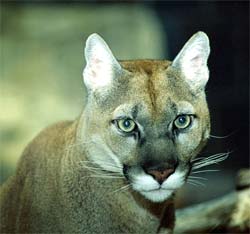 Sizes and Scales: There is a considerable variation in color and size of these animals across their large range of habitats. Adult weights can range from 180-200 pounds. Sizes and Scales: There is a considerable variation in color and size of these animals across their large range of habitats. Adult weights can range from 180-200 pounds.
North American pumas are slightly larger than leopards and similar in size to jaguars. Pumas that live closest to the equator are the smallest, and increase in size in populations closer to
the poles.
Caramel Colored Cats: Pumas are tawny colored with lighter patches on the under body including the jaws, chin, and throat, with some color variation from region to region.

Just the Facts: The puma can run as quickly as 70km/h (43.5 mph), jump 6 m (20 ft) from a standing position, and vertically leap 2.5 m (8 ft). Their bite strength is more powerful than that of any domestic dog. Puma claws are retractable and they have four toes. Their life span is about a decade in the wild and 25 years or more in captivity.
Quiet as a Mouse: Though frequently lumped in with larger cats, the puma is distinct in that it cannot roar, and makes vocalizations 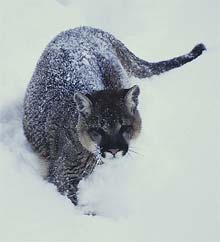 much more common to small cats. In spite of not being closely related to the pantherine big cats, hybrids between pumas and leopards have been bred and are much more common to small cats. In spite of not being closely related to the pantherine big cats, hybrids between pumas and leopards have been bred and are
called pumapards. Hybrids between a puma and an ocelot have also been bred. Hybrids between pumas and jaguars have
been reported, but none have been proven.
Vast Range: Pumas have the largest range of any wild cat. Before the modern human population explosion in the Americas , the puma ranged across most of the Americas . Even now, it has the widest range of any New World land animal, spanning 110 degrees of latitude, from the northern Yukon Territory (in Canada ) to the southern Andes (on both the Chilean and Argentinean sides). They have also been sighted recently in Northern Connecticut and other parts of New England , however, sightings are not generally regarded as reliable enough to serve as scientific evidence.
Pumas in Danger: One of the few locations where the puma is in great danger is within the United States, mainly Florida and other parts of the East Coast. This is mostly due to human infringement, clashing with cities and other urban advancements or because of the loss of territories that urbanization brings. When pumas are found and relocated to more "wild" parts of the state, they are put into competition with pre-existing populations.
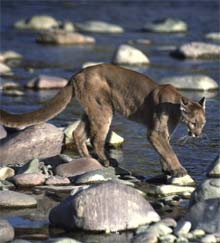 Powerful Predators: Pumas can kill and drag prey about 7 times their own weight. They normally hunt large mammals, such as deer and elk, but will eat small animals, such as beavers, porcupines or even mice, if the need arises. They hunt alone and ambush their prey, often from behind. They usually kill with a bite at the base of the skull to break the neck of their target. The carcass of the kill is usually then buried or partially covered to protect it for several days, while the puma continues to roam and comes back for nourishment as needed. Powerful Predators: Pumas can kill and drag prey about 7 times their own weight. They normally hunt large mammals, such as deer and elk, but will eat small animals, such as beavers, porcupines or even mice, if the need arises. They hunt alone and ambush their prey, often from behind. They usually kill with a bite at the base of the skull to break the neck of their target. The carcass of the kill is usually then buried or partially covered to protect it for several days, while the puma continues to roam and comes back for nourishment as needed.
Pumas do not enjoy being scavengers, however, and will generally hunt for their own food and not eat from a carcass. Pumas will catch and kill their prey 82% of the time, and are consequently finicky eaters. Like other cats, they will also move to certain areas for feeding. Adult males tend to claim a 100 square mile (250 km²) stretch for their territory; adult females take 20 to 60 square miles (50 to 150 km²) on average; however their ranges can vary from as much as 370 square miles (1000 km²) to as little as 10 square miles (25 km²).
Territorial Disputes: Pumas, are more territorial than most cats, especially pumas from desert and very snowy regions. They will mostly avoid fighting and usually ward off others with urine markings, but they do sometimes compete aggressively for territory, especially among the males. Adult Black Bears may be able to kill pumas and steal their kills but generally conflict between the two predators does not occur. Despite being fearsome when it comes to territorial disputes with other pumas or protecting their young (have been seen warding off bears), they are mostly shy and reclusive, and tend to avoid humans.
Puma vs. Human? Attacks on humans are rare, but do occur, especially as humans encroach on wildlands and impact the availability of the puma's traditional prey. There were around 100 puma attacks on humans in the USA and Canada during the period from 1890 to January 2004, with 16 fatalities; California , which has the highest population density of areas with a significant cougar habitat, has had 14 attacks and 6 fatalities. Attacks by puma on humans and pets are associated with urban areas situated in the wildland urban intermix such as the Boulder, Colorado area, which have encouraged the traditional prey of the puma, the mule deer, to habituate to urban areas and the presence of people and pets. Pumas in such circumstances may come to lose their fear of both people and dogs and come to see them as prey.

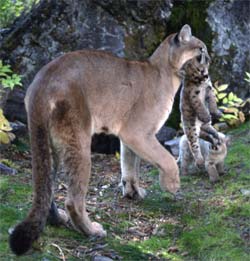
All's Fair... A male may breed with several females. Female pumas usually have 3 or 4 kittens in a den in a rocky location.
If a male puma invades the territory of another male, he may kill the kittens of resident females so that they will become receptive to mating.
Puma kittens have brownish-blackish spots and rings on their tails.

The Comeback Cat: Hunted almost to extinction in the United States and eastern Canada , the puma has made a determined comeback, against the odds, with an estimated 30,000 individuals in the western United States . In Canada , pumas are 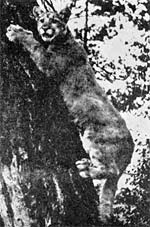 found west of the prairies, in Alberta , British Columbia and the southern Yukon. found west of the prairies, in Alberta , British Columbia and the southern Yukon.
They are also found in smaller numbers within the Canadian Shield regions of Ontario and Manitoba . The densest concentration of pumas in North America is found on Vancouver Island in British Columbia , while in the United States their densest concentration is in the Ventana Wilderness in the Los Padres National Forest, California.In the eastern United States , rumors and myths of pumas never died. But these big cats are slowly making their way from myth to reality -- especially along the Appalachian Mountains from Virginia to Georgia.
There, puma sightings are steadily increasing, and a government bounty is offered in many places for confirmed sightings. One very compelling piece of evidence surfaced in June 1997, when a Kentucky man hit and killed a Puma kitten with his truck. DNA analysis proved that the animal was descended in part from wild North American Pumas, and it showed no evidence of having been someone's escaped pet.
Puma Safety Tips:
1) Do not hike alone, go in groups with adults supervising children. When hiking, appropriate clothing for rough terrain will aid in movement and evasion.
2) If confronted by a puma, do not run; that might stimulate its instinct to chase, and they can quickly outrun any person. Instead, stand and face the animal, but do not make eye contact (experts suggest looking at the feet).
3) Don't "play dead." Pumas are likely to eat a human who plays dead. This behavior is similar to that of Black bears, but unlike Grizzly bears.
4) Pick up young children without bending or turning from the puma (if possible). (Comment: When under an attack by a dog, experts recommend NOT picking up a child; because that act may be interpreted as you attacking, which would encourage the dog(s) to join in the supposed attack. Instead place yourself between the animal and the child. Whether or not this applies to cougars is uncertain.)
5) Do everything possible to appear larger or intimidating, including raising arms wildly, opening up jacket, and throwing stones and branches.
6) Do not crouch down or bend over; this may create the appearance of an ordinary quadruped prey rather than a typically non-prey biped.
7) Run if possible. Do not shoot a wild animal, for the laws protecting it are harsh.
8) Install motion-sensitive outdoor lighting.
9) Keep pets from roaming and never feed pets outside. Be wary when leaving pets outside, particularly at dawn and dusk.
10) Do not climb a tree, as pumas can climb better than humans.
11) Jogging, running, and biking on wildland trails can be particularly hazardous since such runners are likely to be less attentive to the surroundings and the motion can trigger a "chase and kill" reflex in the animal. Talk to local authorities or park rangers to see if it is advisable before taking such a risk.
All text is available under the terms
of the GNU Free Documentation License
|